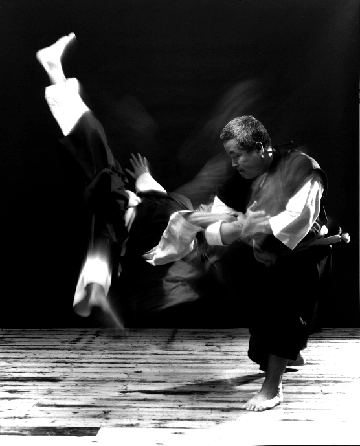topical media & game development




#javascript-processing-example-topic-automata-spore1.htm / htm
<!DOCTYPE html>
<html><head>
<script src="javascript-processing-example-processing.js"></script>
<script src="javascript-processing-example-init.js"></script>
<link rel="stylesheet" href="javascript-processing-example-style.css">
</head><body><h1><a href="http://ejohn.org/blog/processingjs/">Processing.js</a></h1>
<h2>Spore1</h2>
<p>by Mike Davis.
A short program for alife experiments. Click in the window to restart.
Each cell is represented by a pixel on the display as well as an entry in
the array 'cells'. Each cell has a run() method, which performs actions
based on the cell's surroundings. Cells run one at a time (to avoid conflicts
like wanting to move to the same space) and in random order.</p>
<p><a href="http://processing.org/learning/topics/spore1.html"><b>Original Processing.org Example:</b> Spore1</a><br>
<script type="application/processing">
World w;
int numcells = 0;
int maxcells = 4700;
Cell[] cells = new Cell[maxcells];
color spore_color;
// set lower for smoother animation, higher for faster simulation
int runs_per_loop = 100;
color black = color(0, 0, 0);
void setup()
{
size(200, 200);
frameRate(24);
clearscr();
w = new World();
spore_color = color(172, 255, 128);
seed();
}
void seed()
{
// Add cells at random places
for (int i = 0; i < maxcells; i++)
{
int cX = (int)random(width);
int cY = (int)random(height);
if (w.getpix(cX, cY) == black)
{
w.setpix(cX, cY, spore_color);
cells[numcells] = new Cell(cX, cY);
numcells++;
}
}
}
void draw()
{
// Run cells in random order
for (int i = 0; i < runs_per_loop; i++) {
int selected = min((int)random(numcells), numcells - 1);
cells[selected].run();
}
}
void clearscr()
{
background(0);
}
class Cell
{
int x, y;
Cell(int xin, int yin)
{
x = xin;
y = yin;
}
// Perform action based on surroundings
void run()
{
// Fix cell coordinates
while(x < 0) {
x+=width;
}
while(x > width - 1) {
x-=width;
}
while(y < 0) {
y+=height;
}
while(y > height - 1) {
y-=height;
}
// Cell instructions
if (w.getpix(x + 1, y) == black) {
move(0, 1);
} else if (w.getpix(x, y - 1) != black && w.getpix(x, y + 1) != black) {
move((int)random(9) - 4, (int)random(9) - 4);
}
}
// Will move the cell (dx, dy) units if that space is empty
void move(int dx, int dy) {
if (w.getpix(x + dx, y + dy) == black) {
w.setpix(x + dx, y + dy, w.getpix(x, y));
w.setpix(x, y, color(0));
x += dx;
y += dy;
}
}
}
// The World class simply provides two functions, get and set, which access the
// display in the same way as getPixel and setPixel. The only difference is that
// the World class's get and set do screen wraparound ("toroidal coordinates").
class World
{
void setpix(int x, int y, int c) {
while(x < 0) x+=width;
while(x > width - 1) x-=width;
while(y < 0) y+=height;
while(y > height - 1) y-=height;
set(x, y, c);
}
color getpix(int x, int y) {
while(x < 0) x+=width;
while(x > width - 1) x-=width;
while(y < 0) y+=height;
while(y > height - 1) y-=height;
return get(x, y);
}
}
void mousePressed()
{
numcells = 0;
setup();
}
</script><canvas width="200" height="200"></canvas></p>
<div style="overflow: hidden; height: 0px; width: 0px;"></div>
<pre><b>// All Examples Written by <a href="http://reas.com/">Casey Reas</a> and <a href="http://benfry.com/">Ben Fry</a>
// unless otherwise stated.</b>
World w;
int numcells = 0;
int maxcells = 4700;
Cell[] cells = new Cell[maxcells];
color spore_color;
// set lower for smoother animation, higher for faster simulation
int runs_per_loop = 100;
color black = color(0, 0, 0);
void setup()
{
size(200, 200);
frameRate(24);
clearscr();
w = new World();
spore_color = color(172, 255, 128);
seed();
}
void seed()
{
// Add cells at random places
for (int i = 0; i < maxcells; i++)
{
int cX = (int)random(width);
int cY = (int)random(height);
if (w.getpix(cX, cY) == black)
{
w.setpix(cX, cY, spore_color);
cells[numcells] = new Cell(cX, cY);
numcells++;
}
}
}
void draw()
{
// Run cells in random order
for (int i = 0; i < runs_per_loop; i++) {
int selected = min((int)random(numcells), numcells - 1);
cells[selected].run();
}
}
void clearscr()
{
background(0);
}
class Cell
{
int x, y;
Cell(int xin, int yin)
{
x = xin;
y = yin;
}
// Perform action based on surroundings
void run()
{
// Fix cell coordinates
while(x < 0) {
x+=width;
}
while(x > width - 1) {
x-=width;
}
while(y < 0) {
y+=height;
}
while(y > height - 1) {
y-=height;
}
// Cell instructions
if (w.getpix(x + 1, y) == black) {
move(0, 1);
} else if (w.getpix(x, y - 1) != black && w.getpix(x, y + 1) != black) {
move((int)random(9) - 4, (int)random(9) - 4);
}
}
// Will move the cell (dx, dy) units if that space is empty
void move(int dx, int dy) {
if (w.getpix(x + dx, y + dy) == black) {
w.setpix(x + dx, y + dy, w.getpix(x, y));
w.setpix(x, y, color(0));
x += dx;
y += dy;
}
}
}
// The World class simply provides two functions, get and set, which access the
// display in the same way as getPixel and setPixel. The only difference is that
// the World class's get and set do screen wraparound ("toroidal coordinates").
class World
{
void setpix(int x, int y, int c) {
while(x < 0) x+=width;
while(x > width - 1) x-=width;
while(y < 0) y+=height;
while(y > height - 1) y-=height;
set(x, y, c);
}
color getpix(int x, int y) {
while(x < 0) x+=width;
while(x > width - 1) x-=width;
while(y < 0) y+=height;
while(y > height - 1) y-=height;
return get(x, y);
}
}
void mousePressed()
{
numcells = 0;
setup();
}</pre>
</body></html>
(C) Æliens
20/2/2008
You may not copy or print any of this material without explicit permission of the author or the publisher.
In case of other copyright issues, contact the author.

